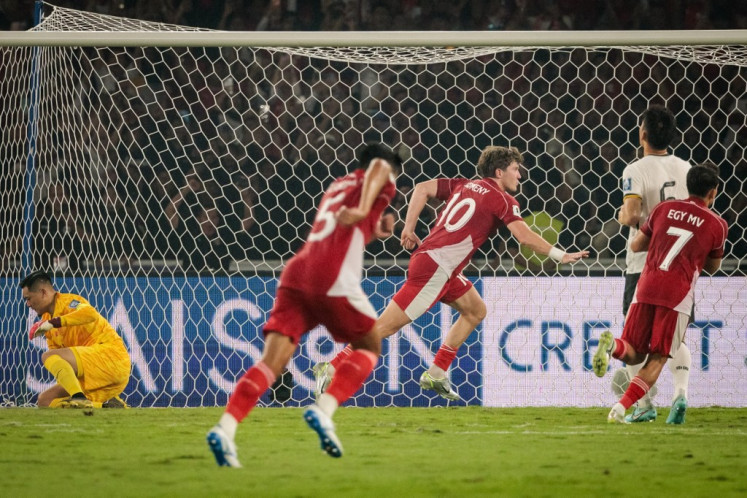The (non) zero-sum game of rooftop solar
With 1 GW peak of rooftop solar at 1:1 net-metering tariff, PLN's revenue would decline by only 0.5 percent.
Change text size
Gift Premium Articles
to Anyone

A
s solar energy is crowned "king of electricity" and its installations continue to expand, it also demonstrates the true meaning of energy democracy. We are talking about distributed photovoltaics (PV) – driven by the wide availability of solar irradiation, the modular characteristics of solar PV systems, the rise of climate action and the increasing access to solar providers.
The International Energy Agency (IEA) recorded net-capacity additions of approximately 38 gigawatts (GW) distributed PVs in the commercial and industrial (C&I) and residential sector for 2020, and projects 46 GW of cumulative installation in 2021 following economic recovery (accelerated scenario). Key markets such as the United States and India showed a brief decline in distributed PV installations, but sensible policies have boosted installation for the residential segment in China and the commercial segment in Brazil.
Today, most distributed PVs are installed on a rooftop. Roofs answer the land/space issue for solar energy utilization, particularly for heavily populated areas. Rooftop solar has become a trend, as a form of long-term investment for consumers for their energy consumption and as an example of environmental action. Architectural landscape now integrates it as part of green buildings.
The Indonesian government has mandated the use of rooftop solar for government offices (minimum 30 percent of roof area) and luxury houses (minimum 25 percent of roof area) stipulated in the National Energy Plan (RUEN).
The Energy and Mineral Resources Ministry has also issued regulations for rooftop solar for the public, namely Ministerial Regulation No. 16/2019 – solid legal protection as an improvement from the previous PLN director's decree.
There are "buts" coming.
Mandatory rooftop solar use has yet to manifest, and the increasing interest from the residential and C&I sectors is met with challenges. The current narrative is almost exclusively about rooftop solar being pitted against PLN's declining electricity sales, the overcapacity of PLN generation, grid instability, the burden of providing balancing power and the dismissal shrug that the public should only use solar energy for self-consumption.
The last point is so deeply ingrained that it is written explicitly in regulation, fueling the argument for not providing better net-metering tariffs and other terms because it is assumed people should be okay with the savings, no matter how small.
Our market studies in Greater Jakarta, Surabaya, Central Java and Bali revealed the opposite. Most respondents want a payback period of less than seven years, meaning the savings from solar installations should be at least 50 percent. Electricity bill saving is in their top three reasons to install rooftop solar. We are talking about ordinary citizens and business owners; the economics obviously matters.
If the government wants the public to contribute to achieving renewable energy and greenhouse gas emission (GHG) reduction targets, then they should listen.
Increasing the share of renewables in the energy mix by 2025 and reducing GHG emissions as stipulated in Indonesia’s nationally determined contributions are two pressing policy deliveries for the government. As PLN is encountering financial constraint and overcapacity, rooftop solar is a win-win solution for both government and PLN. With the supportive policies and enabling environment, it can be fast-deployed and to anywhere in the country, without putting additional burden on PLN to invest in renewable energy generation to meet the RUEN target.
We have seen an increase in rooftop solar installation after the implementation of Ministerial Regulation No. 49/2018. From only 260 users in September 2017, the number is now over 3,500. Industries are installing megawatt-sized rooftop solar as the government reduced the parallel capacity charge – one of the barriers to entry – from 40 hours/month to five hours/month; plus zero-capex financing schemes are now available from solar developers. The residential segment is lacking innovative financing, installments are available but on less attractive terms – yet the market potential is huge.
Revision of Regulation No. 49/2018 is already underway. The latest proposal was to increase the net-metering tariffs to 1:0.75 (typical system) and 1:0.9 (system with battery), from the current 1:0.65. It also extends the reset period to five months from three months and provides an online application system; since users repeatedly complain about the long wait for the export-import meter made available by PLN. Currently, three months is apparently common. The revision points are called improvements, yet our analysis found that the economics are not there.
With 1:1 net-metering tariff, as in 2013-2018, the payback period will decline to below eight years; now, it stands at a minimum of 10 years. Reducing or abolishing the minimum electricity bill similar to a parallel capacity charge for industries will shorten the payback period even more. Extending the reset period for electricity surplus transfer to PLN's grid to one year could also help, signifying the seasonal variation of solar electricity output. These are examples of combinations of variables to make rooftop solar more economically feasible and make it more attractive to users.
Now comes the hard questions: Is rooftop solar a threat to utilities? Is it a zero-sum game in which one side will lose while another thrives?
Our analysis discovered that with 1 GW peak of rooftop solar at 1:1 net-metering tariff, PLN's revenue would decline by only 0.5 percent. Going up to 10 GWp in 2025, the impact on PLN's revenue is still around 4 percent. Rooftop solar in a sizable scale could help PLN reduce its gas power plants’ operation to supply the medium load at noon, thus reducing fuel consumption.
Also, PLN could profit by selling the electricity from rooftop solar to its other customers without actually generating electricity. If planned carefully, rooftop solar could actually benefit PLN in the long term.
The government should consider policy improvements beyond protecting PLN's financial condition. The right ministerial regulation on rooftop solar could lead to massive deployment of solar and have a snowball impact on the economy: development of domestic solar industry, creation of green jobs, emissions reduction and democratizing energy access.
***
Fabby Tumiwa is the executive director of the Institute for Essential Services Reform (IESR) and chairman of the Indonesian Solar Association (ISA/AESI). Marlistya Citraningrum is program manager of sustainable energy access at IESR and managing director of SolarHub Indonesia by IESR.









